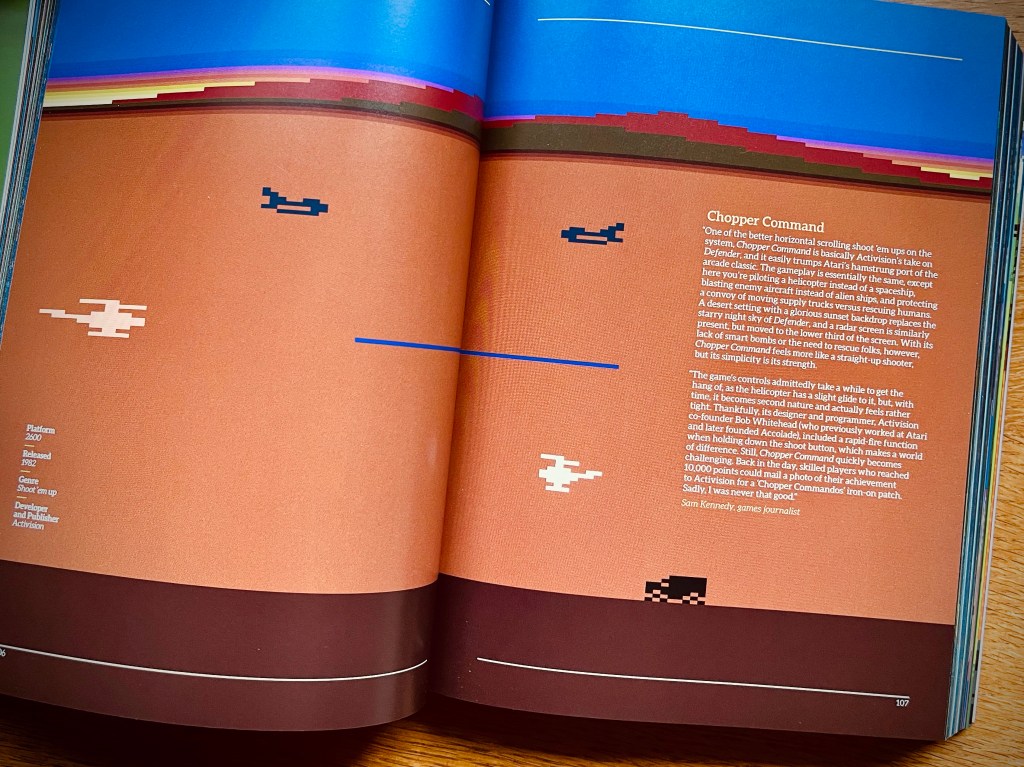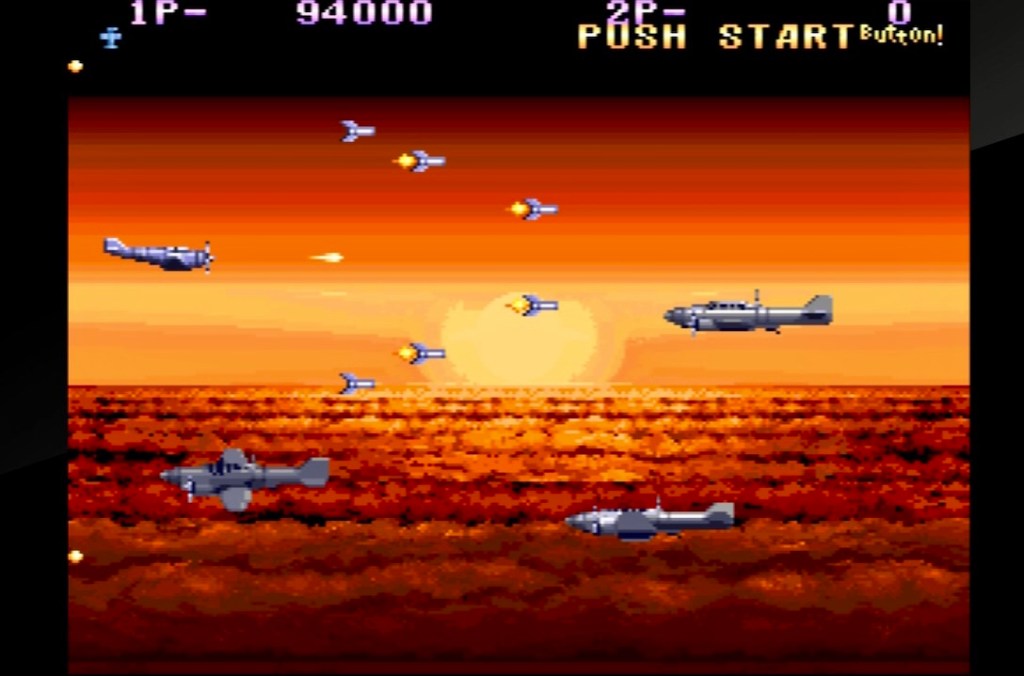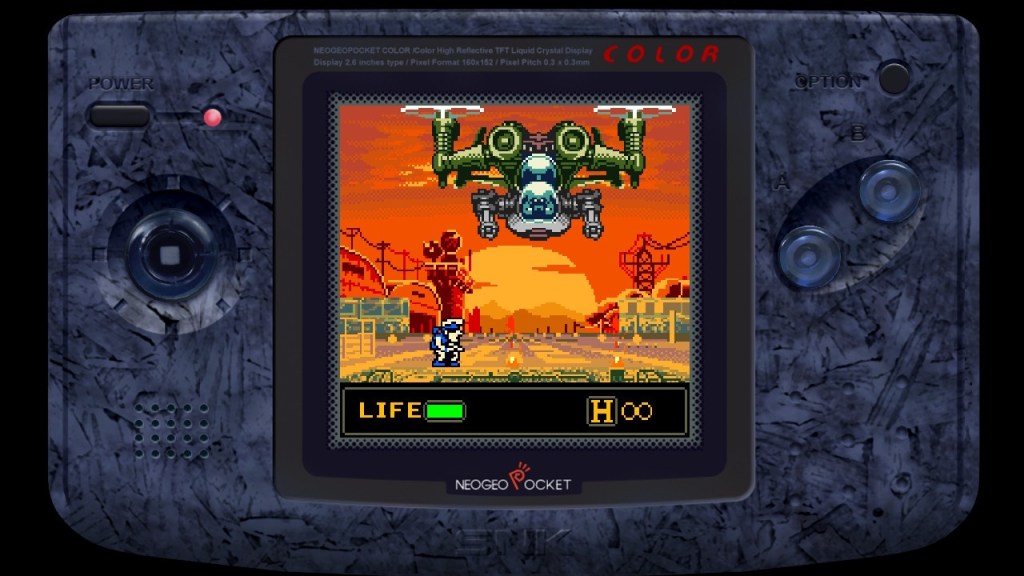Apparently, I started writing whatever this thing about Chopper Command is going to turn into exactly three weeks short of a year ago! Not that there was a lot to it until now – mostly a bunch of screenshots and a few observations; the thing is, I more than covered my (lack of) history with Defender when I covered Jeff Minter’s madcap clone for the Commodore VIC-20, Andes Attack, and Chopper Command is just another one. I needed another angle! And that angle eventually came when I got Bitmap Books’ wonderful Atari 2600/7600: a visual compendium for Christmas 2021 – a book we’re referencing here not for the first time, and certainly not the last I’m sure!

I must admit I’d never really noticed it before, but looking at it here, a few words jumped out at me: “ A desert setting with a glorious sunset backdrop replaces the starry night sky of Defender…” When I first looked at my favourite sights in all of gaming here (before it then got updated here) there was a noticeably good showing from gaming sunsets – specifically, the arcade version of P-47 and Victory Run on PC-Engine. And that’s because I love a gaming sunset, and while Chopper Command’s might be fairly subtle and a little primitive, and not even the best example on the 2600, it’s exactly the proper old sunset I’m talking about! New stuff like Red Dead Redemption, Journey, Wreckfest and Firewatch might well feature some stunning, almost photo-realistic sunsets, but I can look out of the window if I want that! I’m talking blocks of orange on blocks of orange, 8-bit colour gradients and something left to the imagination! And I reckon this is a good opportunity to have a look at a few favourites…

As I just teased it, I’m going to start with 1983’s Seaquest on Atari 2600, which I guess also isn’t a million miles away from Defender, but is both my favourite sunset on the system as well as my favourite game on there full-stop! You’re the pilot of a submarine, fending off sharks and enemy submarines with your torpedoes as you try to rescue wayward divers. It’s a single-screen shoot ‘em up, with the added mechanic of looking after your oxygen supply, which requires a penalised resurface if you haven’t picked up your capacity of six divers before it runs out. Get them all and make it back to the surface though, and you’ll be rewarded with bonus points and the next screen, which is the same again but more and faster enemies. Its sunset couldn’t be more simple, but that’s why it works – just a few carefully selected narrow bands of colour, with a hint of yellow becoming orange then pink, separating the horizon and the expanse of the darkening blue sky above it. I’m not sure why I’ve covered a bunch of Atari 2600 stuff here but not this yet, so we’ll have to come back to why it’s so addictive and such timeless fun another time! Before we move away from the 2600, I should mention the far more in-your-face and eye-popping sunset to be found in Commando Raid from 1982, which I only found when I was reviewing the 2600/7800 visual compendium. It’s a take on Missile Command, with paratroopers dropping out of the sky and into the shelter of bombed-out buildings, where they’ll start tunnelling towards your big gun and your doom if you let them. It’s not a great game, but it is a great sunset, even if I do prefer the minimalism of Seaquest’s. And even more spectacular is the multi-stage sunset on the greatest of the system’s racers, Enduro, and what must be one of the earliest examples of both day / night cycles (including extended dawns and dusks) as well as weather. Another game we need to get to here too!

No such thing as minimalism by 1986 though, and that’s where we’re headed next, away from the 2600 for a stop-off in the arcades. To avoid sunset-overload in something that’s supposed to be about Chopper Command, I’m actually going to skip going too mad on Out Run, but it did know how to do its sunsets! And while there’s definitely some treats to be if you head in the right direction in-game, it’s game over where the real highlight is – the sunset in the high score table is almost as exquisite as the laid-back music playing behind it, turning Seaquest’s brief orange interludes up to eleven with a gradual gradient made up of dozens of shades of orange all the way to black. Head forward a year to 1987 and we can’t ignore the first (and, to many players, probably the only) level in Castlevania arcade spin-off, Haunted Castle, with the sun going down behind the mountains throwing all kinds of light and shadow over your ongoing demise. But for arcade gaming sunsets, nothing compares to the second stage in 1988 side-scrolling horizontal shoot ‘em up, P-47! Even the Spectrum version that I first knew had a decent stab at it! Then the Atari ST version came a lot closer, but when I eventually found the original my jaw hit the floor, with incredible use of atmospheric colour (not to mention an actual setting sun!) coupled with layer upon layer of parallax-scrolling clouds reflecting everything above. I know it’s seen as competent rather than groundbreaking in the genre, but it’s in my top five – I love it, and at the very least that sunset is reason enough to keep coming back!

While we’re talking Atari ST, you can’t talk sunsets and not talk 1987’s Nebulus on there, or Tower Toppler as it was known in the US. The sunset on display here is like a cross between Seaquest and Out Run’s high score table, although Seaquest didn’t have watery reflections like this does! Those reflections shouldn’t be there though – eight naughty towers have appeared in the sea, and your little frog thing, Pogo, has to platform (or pogo) his way to the top of each to shove a bomb in the top… I’ve always wondered if it wouldn’t have been more effective at the bottom, but I don’t suppose that would have left much of a game! It came out on everything, as far as I know to pretty much equal acclaim – brutally difficult but loads of fun. Actually, I was just looking at its reception on Wikipedia, and obviously we’ve got the usually suspects like Your Sinclair and Zzap!64 cited, but this is the one you need to pay most attention to… “In a retrospective review of the Atari 7800 version, “Funkmaster V” gave a 4.5 out of 5, stating that it was a childhood favorite of his and it has the best graphics in the 7800 library.” I hope people respect my opinion as much as Funkmaster V’s one day, but in the meantime that 7800 version is one I’ve never played so will have to have a go on that and see how the sun is setting over there! Before we leave the ST though, quick shoutout to Onslaught, which does a very similar thing but behind some fantasy castle walls in an action-platformer that still looks the part, but really isn’t the game I remember playing when I was trying to justify spending a load of money on it! And quick shoutout to Funkmaster V, of course, too!

We’ve now seen a few orange gradients, but staying in 1987 we’re going to pogo over to the PC-Engine for something a bit different, care of my favourite racer on there, Victory Run… Actually, apart from reasonable ports of Power Drift and the aforementioned Out Run, it’s about the only decent racer it’s got – not exactly its forté, no matter how hard it tried! Anyway, Victory Run is based on the Paris-Dakar Rally, with a deep but non-nerdy vehicle maintenance system, and it’s tough, but also wonderfully unpredictable, giving it real longevity too, even after you think you’ve cracked it. Our sunset is found in the second stage, generated by the day-night cycle that accompanies your progress. You’re now in the mountains as you head south through France, and this brilliant solid orange sky appears over the top of perfectly tinted clouds. I can only imagine how it looks if you actually make it to Dakar, but until then I’m happy for my game to end around here just about every time I play!

We’re going to end this little cruise around various gaming sunsets somewhere almost as exotic as Dakar though, on the Neo Geo Pocket, and I like this one because it’s virtually a mash-up of everything we’ve seen so far! It’s 2000’s (outside of Japan) Metal Slug 1st Mission, and as I write this, it’s also the very last game I got too, a present from my wife as part of the NEOGEO POCKET COLOR SELECTION Vol.1 for Nintendo Switch. Very cool package of ten mostly new to me games (or game variants), and as well as this and 2nd Mission, there’s SNK Gals’ Fighters, Samurai Shodown 2, King of Fighters R-2, The Last Blade: Beyond the Destiny, Fatal Fury First Contact, SNK vs Capcom: The Match of the Millennium, Dark Arms: Beast Buster 1999 and the game I’ve very surprisingly played the most of on here so far, Big Tournament Golf! That said, as a long-time fan of the run and gun series I’ve got some previous with Metal Slug 1st Mission, which is a little toned down and certainly more accessible than some of the other entries in the series, but loads of fun. And everyone who’s played it is going to experience this lovely sunset, as the sci-fi helicopter gunship first stage boss goes nuts outside the best-looking sunlit airforce base since Top Gun!

We can’t top that, and we can’t get any more up to date than that, so time for us to head all the way back to 1982, and co-founder of Activision Bob Whitehead’s Chopper Command on Atari 2600! From the outset, there’s no escaping that this is Defender in another skin, but if we’re talking Atari 2600 Defender, it is to that what Alien is to Pac-Man on there… Meaning it’s not a wildly flickering heap of rubbish! Existence now justified, you’re the pilot of a helicopter patrolling left and right above the desert sands, taking out increasingly hostile enemy aircraft while protecting the convoy of trucks on the ground. The controls are straightforward, and you’ll quickly adapt to the chopper’s turning circle as you change direction, turning it into an intuitive directional aerial drift which soon feels great. What’s also very nice is the continuous fire mode when you hold down the fire button, which, together with the difficulty, could also be tweaked on the original hardware’s settings switches. Overall, it flies great!

At the bottom of the screen there’s a long-range scanner, showing the full combat zone you’re flying about in, with the convoy represented as yellowish dots on the ground, enemy aircraft are bigger yellowish dots in the air, and you’re a red dot. Incidentally, the instruction manual helpfully informs us that the range of scanner is five miles, while the play area shown on-screen at any time is one mile, so we can deduce that you’re scrolling through about five screens before you loop around on yourself! Clear the level of enemy aircraft and you move on to the next, where things get faster and more intense. Each level starts with twelve enemy aircraft, and twelve trucks in your convoy. You get 100 points for a helicopter, 200 for a fighter jet, then when they’re all done you’ll get a bonus for the number of trucks they haven’t bombed yet multiplied by the level you’re on (of which there’s ten) multiplied by a hundred. You started the game with three lives, and get another up to a maximum of six every 10,000 points. Got that? It’s important, because if you score 10,000 points or more, you can join the Activision Commandos! Just send them a picture of your telly as proof and they’ll send you an iron-on Commandos emblem patch! As an aside, the Activision address included always gives me a little thrill because it’s the same road where my own company used to be in Santa Clara, California, and I’ve been there loads of times. Never got a patch though!

I’ve said it before, but you can always rely on Atari 2600 instructions to deliver gold like that, and while you already know way more than you need to know to have fun with Chopper Command, it doesn’t stop there, because Bob Whitehead is also going to tell you exactly how to become a “Commando” at Chopper Command, and this is so priceless that you’re getting it in full…
How to Become a “Commando” at Chopper Command by Activision
Tips from Bob Whitehead, designer of Chopper Command
Bob Whitehead is a Senior Designer at Activision. Before creating Chopper Command, Bob designed Boxing, Skiing and Stampede for Activsion.
“As you’ll soon discover, Chopper Command takes quick reflexes and keen coordination. However, there is a strategic side to the game as well.”
“For example, your truck convoys will always travel from the right to the left. And so will the enemy formations. Knowing this, you can position yourself at the left side of the screen and start firing as soon as the enemy aircraft appear. This is important because your helicopter’s chances of being hit by a multi-warhead missile increase the closer the enemy aircraft get. The enemy pilots are real kamikazes, too, and they’ll collide with you if they can’t shoot you down.”
“Good luck! I hope you have as much fun playing Chopper Command as I had designing it. God Bless.”
Bob Whitehead
P.S. Drop my a line. I’d sure like to hear how our guys are doing at the front.
Now there’s no excuse for you not to earn that patch – you know everything to be an expert… Weird quotation marks, several original typos and all! Patch availability in 2022 aside though, this game is still fantastic! While it is a Defender rip-off, you’ll have noticed that you’re not “rescuing” here, so there’s a simplicity that lumps it more into classic horizontal shoot ‘em up territory, and definitely does it no harm. Which I’ve just noticed is what my visual compendium says too! That said, Defender’s added complexity does it no harm either – unless it’s the 2600 version, where your ship disappearing every time you shoot is the least of your worries!

No such glitches here. That bi-directional scrolling play-field scrolls way more smoothly than it has any right to, and I love the way it decelerates to a stop before changing direction when you turn the other way! There’s no flicker, and while there’s not much to any animation, your cannon fire and explosions and so on do the job just fine. There’s not a lot to your helicopter or any of the other vehicle sprites either, which are all single colour but perfectly identifiable if nothing more. The action is cleverly restricted to a blanket block of single-colour sand to allow for the scrolling magic to happen at the top of the screen, where varied (and multi-coloured) mountains give way to that sunset we began with and the sky beyond. And how does that sunset rate? Well, it’s not quite as artistic as Seaquest or as bombastic as Commando Raid, but there’s a definite impression of the sun dipping down below the mountains, creating subtle red shadows where the mountains begin and gradually darkening as it reaches up into the clear blue sky. Where they meet isn’t quite so subtle, but it works fine, and I reckon the whole colour palette has been created to enhance this handful of narrow, coloured bands, so we can forgive that! Quick note on sound – it’s minimal, but what’s there is a very impressive. There’s the constant up and down drone of a surprisingly realistic helicopter rotor-blade doing its thing, and a real heft to the cannon fire and explosions over the top.

Getting this stuff right, rather than failing to make it spectacular, is what can elevate something like Chopper Command way above its official source material. It looks good, it sounds good and it moves good, with tight controls and a frantic but mostly predictable enemy AI, with enough random occurrences to keep things fresh and as addictive as hell. This is a classic, derivative or not! I mentioned Seaquest being my favourite 2600 game earlier, and the greatest Pac-Man of them all (that isn’t a side-scrolling platformer), Alien, would be number two. I think another chasey-mazey game, Dark Cavern, might be number three, but Chopper Command is very close behind. And that would leave Enduro to fill out the top five! Just don’t ask me to choose between this and Andes Attack on VIC-20 as best Defender clone!

